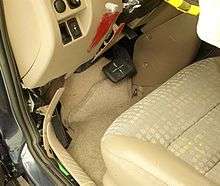Footwell intrusion
In the field of automotive engineering, footwell intrusion describes a situation in which an automobile engine or other vehicle component penetrates the space normally allocated for the feet of the front seat occupants. Automotive crash testing agencies such as Euro NCAP and IIHS consider levels of footwell intrusion when conducting assessments.[1][2] Vehicles that display excessive deformation of the footwell are noted.[3]

Aftermath of NHTSA crash test of a 2004 Ford Escape showing healthy footwell intrusion.
This phenomenon is of interest to help prevent injuries to passengers' lower legs and feet.[4] Studies have shown the interaction between feet, pedals and invading vehicle parts is directly linked with damage to the ankles, tibia and adjoining cartilage.[5]
References
- "Frontal Impact". Test Procedures. EURO NCAP. Archived from the original on 22 May 2007.
- Klanner, Wilfried (June 2001). Status Report and Future Development of the EURO NCAP Programme (PDF). 17th International Technical Conference on the Enhanced Safety of Vehicles. Amsterdam: US Department of Transportation.
- "Ford Mondeo". Tests. EURO NCAP. Archived from the original on 14 May 2007.
- Thelen M, Raffauf R, Buss W, Roth W, Hillenbrand K (June 1998). Simulation of Foot Well Intrusion for Sled Testing (PDF). 16th International Technical Conference on the Enhanced Safety of Vehicles. Windsor, Ontario, Canada: US Department of Transportation.
- Kallieris D, Riedl H, Mattern R (June 2001). Response And Vulnerability Of The Ankle Joint In Simulated Footwell Intrusion Experiments—A Study With Cadavers And Dummies (PDF). 17th International Technical Conference on the Enhanced Safety of Vehicles. Amsterdam.
This article is issued from
Wikipedia.
The text is licensed under Creative
Commons - Attribution - Sharealike.
Additional terms may apply for the media files.